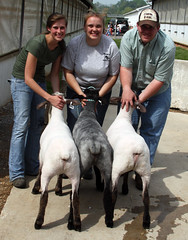
Lamb tails

Properly docked lambs

A rat-tail
East Friesian

A fat tail or rump
Egyptian Rahmani
|
In two shakes of a lamb's tail
Tails are natural
Tails are a natural part of sheep. Lambs are
born with tails. The length of a lamb's tail is usually half-way between
the length of its mother's tail and its father's tail. In fact,
tail length is one of the most heritable traits in sheep. Up to 84 percent
of the variation in sheep tail length is due to genetics.
The purpose of the sheep's tail is to protect the sheep's anus,
vulva, and udder from weather extremes. Sheep lift their tails
when they defecate and use their tails, to some extent, to scatter
their feces.
No tails!
Under modern sheep production systems, tails are usually
docked (shortened) to prevent fecal matter from accumulating
on the back side of the sheep, which can result in fly strike
(wool maggots). Left untreated, fly strike can be fatal, as the maggots eat away at the sheep's flesh. Tail docking also makes it easier to shear
the sheep and process them for meat. The tail does not interfere with breeding or lambing.
There are different methods that can be used to dock the tails
of lambs. The most common method is to put a rubber band (ring) around
the tail. When this method is used, it is recommended that lambs be docked at a young
age (1 to 7 days) to minimize the stress and pain experienced
by the lamb. The dock (tail) should be left long enough to
cover the ewe's vulva and ram's anus. Short tail docks may contribute to the incidence of rectal prolapses.
While some animal activits claim that tail docking is an inhumane practice made necessary by modern production practices, this claim is simply untrue. When done properly, tail docking is not inhumane. While it causes some pain, it does not affect the health or growth of the lamb. Tail docking is done to protect the health and hygiene of sheep and lambs. Liquid feces (diarrhea) can occur in all production systems; thus, putting the sheep at risk for flystrike.
Hair sheep
It is usually not necessary to dock the tails of hair
sheep breeds, including Katahdin, Dorper, American Blackbelly, Barbados Blackbelly,
Damara, St. Croix (Virgin Island White), Wiltshire Horn, Pelibüey,
Santa Inês, St. Augustine, and Royal White®.
One of the unintended consequences of selecting sheep for wool growth was longer, thicker, woolier tails. Hair sheep tails are more similar to the ancestor of modern sheep, the Mouflon, which has a short, wooless tail.
Rat-tailed sheep
Some wooled breeds have naturally short tails or thin, woolless
tails that also do not require docking. These breeds are called Northern
European short-tailed or "rat-tailed" sheep. They
include Finnsheep, East Friesian, Shetland, Icelandic, Romanov,
and Soay.
Because East Friesians are a dairy sheep, their tails are usually docked to create a more sanitary environment for milking.
Fat-tailed sheep
Some sheep have fat or broad rumps and/or tails. These kind of sheep comprise 25 percent of the world's sheep population. They are hardy and adaptable, able to survive the tough challenges of desert life and other extreme climatic conditions.
It
is not customary to dock their tails. In fact, the tail
fat is considered a delicacy in some cultures. Sheep-tail fat is
called "allyah" in Arabic. Historical religious text
(Hadith) claims that sheep-tail fat is a "cure" for
sciatica (lower back and leg pain caused by irritation of the
scaitic nerve).
Fat tails are also a result of artificial selection, as some ancient cultures needed a source of fat for cooking and selected sheep that could provide it.
Naturally-docked sheep
Using the short-tail breeds (e.g. Finnsheep) as a foundation, scientists in
Australia and New Zealand are trying to breed sheep with naturally
short tails that do not require docking. Years ago, researchers in the U.S.
successfuly bred "tail-less" sheep. Unfortunately, the tail-less
trait was linked to a lethal gene, similar to the one in Manx cats.
<== ABOUT SHEEP
|